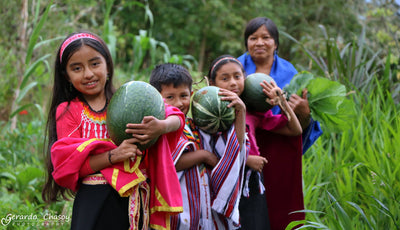An Introduction to Coffee - PART 1 -


Don Miguel, traced us back to the roots, literally to the actual roots, and just like that we became his students. He began to teach us from the microscopic to the macroscopic level, starting at the soil. Don Miguel described the soil as a live mechanism, perhaps the most important part of the whole production. Much like permaculture and biodynamics explain the soil itself is the building block of the plants life, it is full of beneficial bacteria, mineral, organic compounds, living organisms and nutrients that in conjunction with different elements we will touch on later eventually give the plants the distinctive characteristics of aromas and flavors.
We learned then that the method of production would impact what we got as final product and therefore our body’s response to each cup. Don Miguel proceeded to share how the high demand of coffee has caused a negative effect on agricultural practices. Large scale producers adopted hot climates, low altitudes & Mono-cropped styles of production, stripping away any surrounding vegetation or “invasive” species, removing the ground cover layer to avoid “weeding” in order to guarantee a fast turn around manufacturing. This practices impacted the the nutrition and quality of the precious soil.
Exposed soils without a ground cover laid bare under the sun, create a hostile environment for the beneficial microorganisms to thrive, because the transportation systems at the mycelium level are not present, the absorption and exchange of nutrients and minerals is greatly reduced. The replenishment of nutrients back into the soil is also a draw back creating weaker plants that are more prone to diseases & pests making the producer implement chemicals a necessity, yielding less richer coffee year after year. Erosion and infertile soil are the unfortunate final result of this industrialized practices who in chase of profitability forget the connection to earth as a sacred organism, delegating the functions of caring to automated machines, cutting entirely the cord of the human aspect in the tending of the land and handling of its fruits.

Moving on, our new teacher touched on the harvesting process and once more we got to learn first hand what has occurred. Traditionally grown coffee plants used to be harvested exclusively by hand, the workers would have enough experience to select only the ripest fruits and keep the underdeveloped ones attached to the plants to practice “graining” (small recollection of late harvests later in the season). Now days mass producers meticulously keep plants at “shrub” level, machinery executes the harvesting, overripe, ripe and underripe coffee cherries are equally collected, but to what cost?
Going back to the plant biology….Coffee plants are incredibly smart, in fact they are so adaptable that under no shade they are capable of producing natural oils to coat their leaves and subsidy sun damage, they are also incredible at protecting themselves from stress factors, such as rough handling, (abrupt picking, branch snapping, etc) by producing tiny amounts of a stress hormone (abscises acid) to deter / slow down the affecting factors. That’s when the puzzle pieces began to take shape, my body’s discomfort was not the result of just coffee but the QUALITY of it.

Don Miguel explained to us, the importance of the post harvesting process, how the fruits themselves demand “their times” and how a true artisanal producer must develop the intuition of working with them. He described how like in the world of wine depending on the processing method the results are very different from one another. He reiterated the significance of the human aspect in the proper determination of the post harvest stage, from accurately diagnosing, color, smell, texture, stickiness, and temperature prior of reaching the drying phase. Is no surprise that this skills have gotten lost in an era where technology seems more convenient, this once again comes with a price on the side of the final consumer. As far as farming processes go, now days for most small coffee farms, the chain ends at the drying of the bean, while mass producers of course will have the machinery to execute fast drying + refinery (roasting, grinding, packaging).
A new question arose. What exactly happens to small farms and their dried green bean? Don Miguel explained, that back in 1927 the Colombian government created an institution to defend the rights of Colombian Coffee producers and represent their interest as well as ensuring that the macroeconomic and sectoral policies of the state benefited the coffee producer. What it started as a great idea throughout the years drifted creating a gap in the empowerment of the small farmer. The original movement encouraged the sale of the prime material (green bean) to be refined, roasted, packaged and commercialized by a third party, this would of ensure an outlet for small farms to sell their product but what happened after is not often discussed.
The regulatory agents that focused on the trade of raw material created the initial boom that popularized Colombian coffee, but over time disempowered the small producer who was not earning enough to purchase and implement their own refining equipment limiting them exclusively to the sell of bulk green bean for export. Why is this so bad?
It all comes down to this, at the large scale and much like what I first experienced living abroad, Colombian coffee became a trademark, the packaged beans became a conglomerate of green beans from many farms in the country, all collected into a large pool, refined, roasted, in some instances chemically enhanced to achieve “even flavors” and finally sold at astronomical rates. For the small artisanal farmer this represents a defeat as the standardized trade rates of unroasted green bean are in average between $0.20-$1.09 USD per pound. This number is dangerously low because it means the farmers either break even or won’t turn around any profit for the year perpetuating the “Handicapped” cycle.

So where’s the Coffee Jackpot going? welcome to the latest boom, artisanal roasted coffee. All around the world local roasters have gained more and more popularity in the past decade, places like Hong Kong, Canada and the United States rank amongst the top coffee revenues with numbers that reach up 80 Billion dollars a year. While I am not trying to discredit artisanal roasters here, I am offering you a different view of what we are supporting with our currency and extending an invitation to question and reevaluate the ethical practices behind our consumption, who and where are our providers outsourcing their material?
Don Miguel also described how the sale of raw beans further affects the artisanal producer, by doing so the farmer does not get the chance to have feedback of the final bean giving them a blind spot to accurately make improvements to the soil in terms of nutrition, shade, watering, layout, etc. He explained also the conglomeration of different quality green beans roasted evenly is reflected in the health discomforts I’ve originally experienced, because it makes virtually impossible to anyone to determine who or how much, chemical enhancement went into the production of the primary material, therefore, body responses like acid reflux, the so called “jitters” and energy associated crashes have now become a standard.
By the end of our lesson, not only we were able to to resolve our questions, we gained a different perspective and began to look at each cup of coffee differently, each bag on the shelve had a story to tell us. Every tiny Coffee Bean was infused with a background, the love and tending of individuals like Don Miguel and his crew, who often in the vast ocean of the markets go unnoticed. With each sip and bodily response a little glimpse of the styles of production, from harsh and bitter notes result of the dark side of marketing and profit; to heavenly delicate and silky notes that embrace our pallate, a ceremony accompanied by the sweet tinge of flavor, a hug in a mug, filled with the laughter, resilience, hopes and dreams of the “Hands behind its crafting”

What happened after…. stay tunned for part II.
From the people, for the people.

Natalia G.
Cosmic Coven


